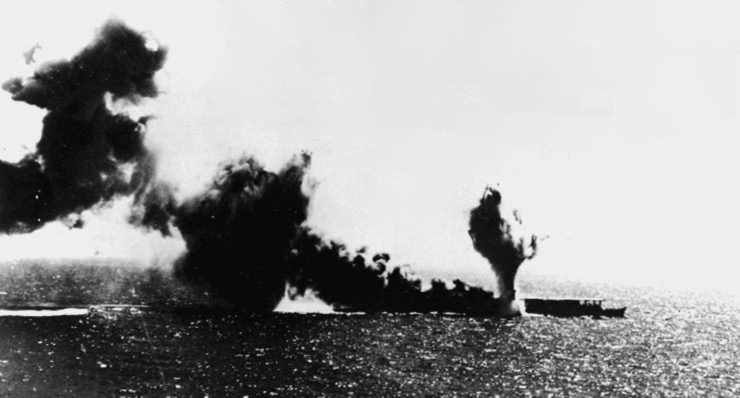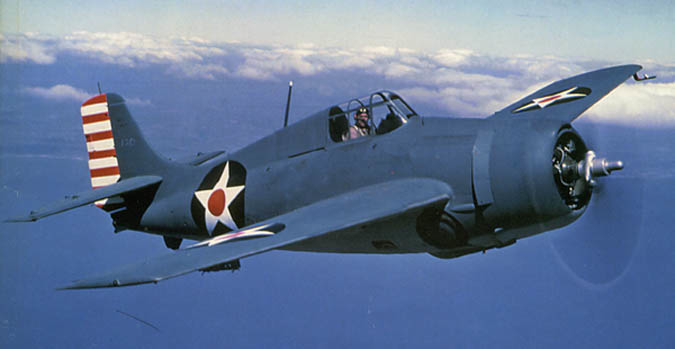The Battle of the Coral Sea

(art by Robert Taylor)
Â
The Battle of the Coral Sea
Â
For nearly half a year after the attack at Pearl Harbor, Japan had enjoyed an unbroken string of victories: Guam, Wake, Hong Kong, Singapore, and more. Â To isolate Australia from her American allies, Japanese military planners decided to seize Port Moresby in New Guinea and Tulagi in the Solomon Islands. Â Fleet carriers were to provide air cover for the invasion fleets and surface forces.
US Navy signals intelligence ferreted out enough details of the Japanese plans that American carriers were positioned in the Coral Sea to counter the Japanese move on Port Moresby.
At the Battle of the Coral Sea, for the first time in the history of naval warfare, opposing fleets would fight an entire battle without either side’s ships ever sighting or firing at each other.  Carrier-based aircraft - not ships - would take the fight to the enemy.
During the first day of the battle, American search planes found the Japanese force guarding the Port Moresby invasion fleet.  An airstrike was launched.  After inflicting mortal damage on the Japanese carrier Shoho, Lt. Cmdr. Robert E. Dixon radioed to the Lexington, “Scratch one flattop!â€
Â
SIDE BALANCE ========================================
Â
Allies: 50%
Axis: 50%
Â
AIRCRAFT ============================================
Â
---- Axis ------------------------------------
Â
A6M2 "Zero" min 20 - max 75
B5N2 "Kate" min 20 - NO max
D3A1 "Val" min 20 - NO max
Â
---- Allies -----------------------------------
Â
F4F-4 "Wildcat" min 20 - max 75
B5N2 "Kate" min 20 - NO max (stand-in for Douglas TBD "Devastator")
SBD-5 "Dauntless" min 20 - NO max
Â

Â
SPECIAL RULES ==========================================
Â
1.) A maximum of 70 aircraft may be based on any single Aircraft Carrier.
2.) At least 10 aircraft must be assigned to defend each fleet.
3.) Fleets must be attacked within the first 60 minutes of the frame.
4.) Each side must order at least 10 ordnance-carrying planes to attack each enemy fleet.Â
5.) Bomber formations are NOT enabled.
6.) Fighters (A6M and F4F) may not carry bombs or rockets (drop tanks optional).
7.) The USN F4F-4 is a stand-in for the F4F-3 and so must use the 4-gun armament.
8.) The B5N torpedo planes may not carry bombs (scouts may fly unarmed).
9.) Fleets must stay in their assigned zones on the map.
10.) Aircraft must all launch from Aircraft Carrier (CV) fleets.
Â
SCORING ==============================================
Â
Aircraft PointsÂ
---------------
Fighter Aircraft 2 points
Single-engined Bomber 4 points
Â
Ship Target Points
-------------------
Destroyer (DD) 25 points
Cruiser (CA) 50 points
Aircraft Carrier (CV) 100 points
Â
End Of Frame Landing Bonus
--------------------------------
A good landing at a friendly airbase (see objectives map) or carrier earns 5 points per pilot at the end of the frame.
Â
Friendly Fire Penalty
----------------------
Accidentally shooting down a fellow countryman incurs a penalty equal to two times the normal aircraft value (see Aircraft Points, above).
Â

Â
ARENA SETTINGS ============================================
Â
Terrain map:  New Britain  ("newbrit")
Fuel burn rate: 1.0
Anti-aircraft gun strength: 0.3
Bombsight calibration: AUTOMATIC (MA standard)
Icons: 3.0K yards (9,000 feet)
Sector Radar ("bar dar"): OFF
Dot Radar: OFF
Fighter and Bomber warning range: 52,800 feet (10 miles)
Tower range set to 52,800 feet (for display, to match the above setting)
Haze range: 15 milesÂ
Friendly collisions: OFF
Enemy collisions: ON
Kill shooter: OFF
Stall Limiter: ON (not mandatory, but available as pilot's choice)
Â
Wind:
--------
  altitude     speed     direction
  00 - 02K    5      SE -> NW
  02 - 10K    10     SE -> NW
  10 - 18K    15     SE -> NW
  18 - 26K    20     SE -> NW
  26 - 30K    25     SE -> NW
  30K+      -199     DOWNDRAFT
Â
Arena Clock
--------------
Frame 1 Â Â Â Â 10:00 Â Â (10:00 AM, Morning)
Frame 2 Â Â Â Â 12:00 Â Â (12:00 PM, Noon)
Frame 3 Â Â Â Â 14:00 Â Â (2:00 PM, Afternoon)
Â

Â
NOTES ================================================
Â
For much of 1942, both the IJN and the USN typically embarked only about twenty fighters on a carrier. Â Both the USN and IJN did sometimes use dive-bombers to defend CVs against low-level torpedo plane attacks.
Â
This is an update of my very first FSO design, which was for the October 2011 event "Scratch One Flattop!"
Â
Design by Bino for the June 2015 FSO
04-Jun-2015
version 1.03
Â
Â